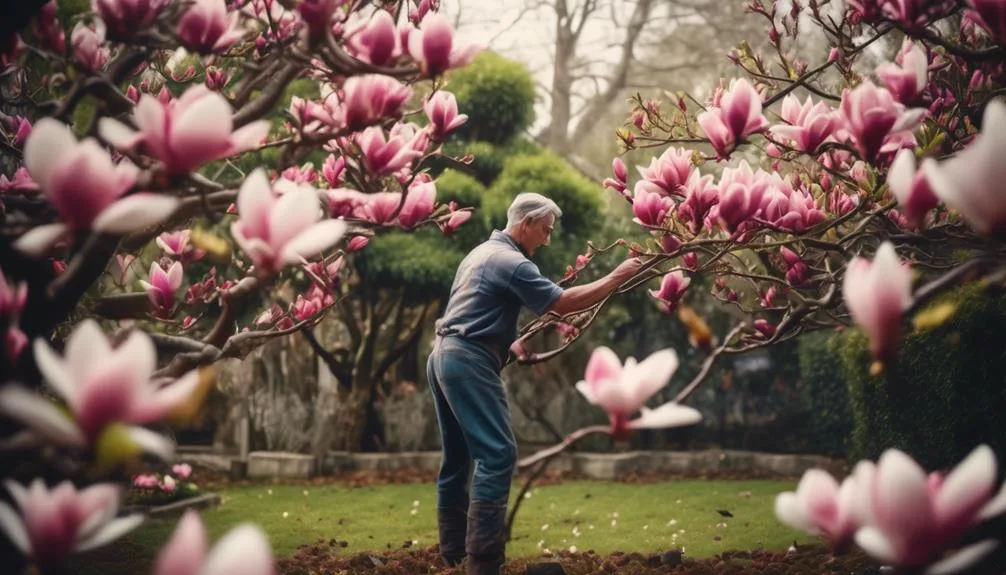Encouraging your magnolia tree to bloom can be challenging, but there are practical methods to help. By understanding soil, fertilization, pruning, and training, you can unlock your tree's full potential.
These strategies can coax beautiful blossoms from your magnolia tree. Let's explore effective techniques to transform your magnolia into a stunning display of flowers.
Soil and Fertilization
To encourage your magnolia trees to flower, it's essential to ensure they're planted in well-draining soil and receive the appropriate fertilization.
Start by testing the pH balance of the soil to ensure it falls within the optimal range of 5.0 to 6.5 for magnolia trees. This is crucial as it affects the tree's ability to absorb nutrients.
Check the nutrient levels in the soil as well, ensuring there's an adequate supply of nitrogen, phosphorus, and potassium.
When it comes to fertilization, consider using organic fertilizers, which release nutrients slowly and improve the soil structure over time. Synthetic fertilizers, while providing a quick nutrient boost, can harm the soil's microbial activity if overused.
Pruning and Training
Wondering how to prune and train your magnolia trees for optimal flowering? Proper pruning and training are essential for encouraging healthy growth and abundant blooms.
When pruning magnolia trees, focus on enhancing their natural branch structure to promote airflow and light penetration. Start by removing any dead, damaged, or crossing branches. Additionally, prune to open up the center of the tree, allowing for better air circulation.
Consider the growth patterns of your specific magnolia variety when training the branches. Some magnolias have a more upright growth habit, while others may spread wider. Train the branches accordingly to maintain an attractive shape and encourage balanced growth.
Proper Watering Techniques
When it comes to proper watering techniques for magnolia trees, it's crucial to ensure consistent moisture without overwatering. Magnolia trees have shallow root systems that spread wide, so it's important to water them deeply to encourage deep root growth. Here's a simple guide to help you ensure your magnolia trees receive the right amount of water:
| Root Depth | Water Frequency |
|---|---|
| Shallow (1-2 feet) | Every 7-10 days |
| Deep (2-3 feet) | Every 10-14 days |
Water deeply to reach the entire root system, providing about 1 inch of water each time. During hot, dry periods, increase the frequency slightly. Always monitor the soil moisture to prevent overwatering, which can lead to root rot. By following these watering techniques, you can help your magnolia trees thrive and bloom beautifully.
Sunlight and Location
If you've mastered the proper watering techniques for your magnolia trees, now it's time to consider the crucial role of sunlight and location in ensuring their healthy growth and abundant flowering.
Magnolia trees, depending on the species, have varying growth habits and sunlight requirements. For instance, Southern magnolias thrive in full sun to partial shade, while Saucer magnolias prefer full sun but can tolerate some light shade.
It's essential to choose a location that provides the right amount of sunlight for your specific magnolia species. Ensure that the chosen spot has well-draining soil and offers protection from harsh winds, as these factors can also impact the tree's overall health and flowering potential.
Pests and Disease Management
To protect your magnolia trees from pests and diseases, regularly inspect the foliage and trunk for any signs of infestation or infection.
Integrated pest and disease management involves using a combination of cultural, biological, and chemical control methods.
Encouraging beneficial insects like ladybugs and lacewings can help keep pest populations in check.
Additionally, practicing good garden hygiene by removing fallen leaves and debris can reduce the risk of disease.
Natural remedies such as neem oil or insecticidal soaps can be effective against common pests like scale or aphids.
When using chemical controls, always follow the instructions carefully to minimize harm to beneficial insects and the environment.
Conclusion
Incorporating the right soil, pruning, water, and sunlight will nurture your magnolia trees to bloom vibrantly.
Stay vigilant against pests and diseases, and tend to your trees with care.
With these steps, your magnolia trees will soon be adorned with stunning flowers, bringing joy and beauty to your surroundings.

My interest in trees started when I first saw the giant sequoias in Yosemite.
I was a teenager then, and I remember thinking, “I need to learn more about this.”
That moment stuck with me.
A few years later, I went on to study forestry at Michigan Tech.
Since graduating, I’ve worked in a mix of hands-on tree care and community education.
I’ve spent over ten years helping people understand how to plant, maintain, and protect the trees in their neighborhoods.
I don’t see trees as just part of the landscape.
They are living things that make a real difference in our daily lives.
